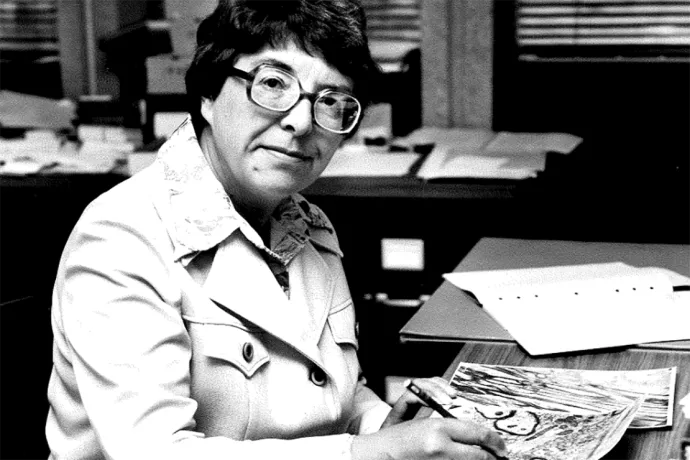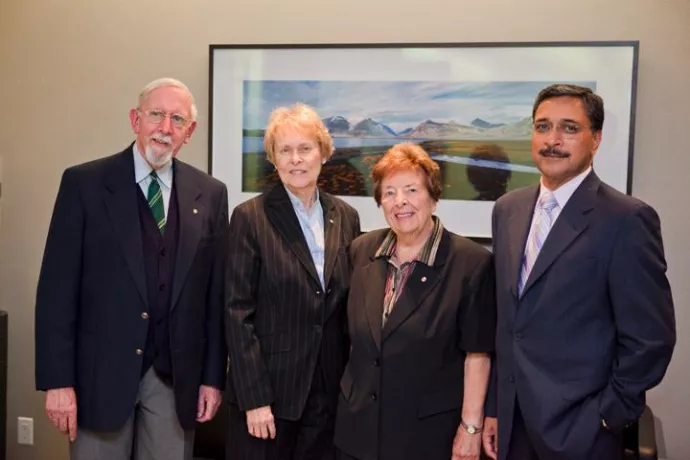
Brilliant, witty and fearless: UTM remembers Betty Ida Roots
The University of Toronto Mississauga community is remembering Betty Ida Roots, an accomplished scientist and eminent scholar whose determination and drive for excellence saw her reach the highest ranks at a time when female scientists faced roadblocks due to gender bias.
Roots, a professor at Erindale College (now UTM), died on Oct. 24 at the age of 93.
“When Betty arrived at UTM in 1969, women in science faced many more barriers than today. Often, they were relegated to lower ranks such as lecturer,” says UTM astronomy Professor Emeritus John Percy, noting that women at the time were less likely to reach full professor. “But Betty was solidly in the research stream, had a strong research program and graduate students, and was promoted to the highest rank.”
Not only was Roots promoted to full professor, she served the university in a number of roles, including assistant chair of Zoology (1972-1975), associate dean of science at UTM (then Erindale College) from 1976 to 1980 and was the first female chair of the Department of Zoology (now CSB and EEB) from 1984-1990.
Even after assuming her role with the Department of Zoology, Roots maintained a strong research presence at UTM.
“In the physical sciences at UTM, there was a tendency for faculty to either have their labs downtown (because that’s where their colleagues and grad students were) or to demand to be transferred downtown,” Percy says.
A pioneer when it came to using electron microscopes to photograph and analyze molecular details within the cells of the nervous system, Roots established and directed the electron microscope facility at UTM. Her first graduate student, Roberta Bondar (PhD 1974), worked with Roots to set up the microscopy suite.

Not all lessons with Roots were relegated to the lab.
“The unusual out-of-doors fieldwork experience was memorable and an ongoing source of camaraderie, infrequent in a dark electron microscope suite,” Bondar says, recalling one noteworthy – and humorous – foray into the field.
Bondar explains that Roots studied the effects of environmental changes in the brains of animal models, such a goldfish. To offset some of the costs associated with ordering fish from suppliers, Roots came up with the idea of thinning out goldfish stock at private ponds across the GTA.
“We mounted an expedition, as she liked to call any trip outside of Erindale (College), to gather up the critters,” Bondar recalls. “The water from the buckets and livestock sloshed around the floors of our cars, and by the time we returned to the university, the cost of the gas and cleaning of the cars compensated for the revenue lost to any duties, transport and taxes that would have been on any imported goldfish.”
Described as “brilliant, fearless, witty, loving and far-seeing,” Roots, who is also a founding director of The Roberta Bondar Foundation, was nicknamed “Intrepid.” It is what her middle initial represented to those who knew her.
Remembered as “down-to-earth,” Percy adds that she was also “sensible” and “no nonsense.”
“That made her very easy to deal with and helped her get things done,” he says.
Born in South Croydon, Surrey, England in 1927, Roots’s early scientific curiosity led her to collect specimens around her home. She studied at University College at University of London, where she earned a BSc (Special Honours) and later a PhD in zoology, specializing in comparative physiology. Roots continued to conduct research in neuroscience in London, later emigrating to Canada in 1969 due to the gender bias she faced at home.
Roots is the recipient of many awards, including a DSc degree from the University of London, England, for her achievements in research in the fields of comparative physiology and neurobiology. She was an elected fellow of the Royal Society of Canada and active with the Royal Canadian Institute (now RCIScience), serving as president in 1994, at a time when female presidents were in the minority. She served as editor-in-chief of RCIScience’s 150th anniversary book, Special Places: The Changing Ecosystems of the Toronto Region, which was nominated for a Toronto Book Award. One of her many lasting legacies is the collaborative PhD program in neuroscience at the University of Toronto, which she initiated and developed.
~With files from Neil Macpherson
